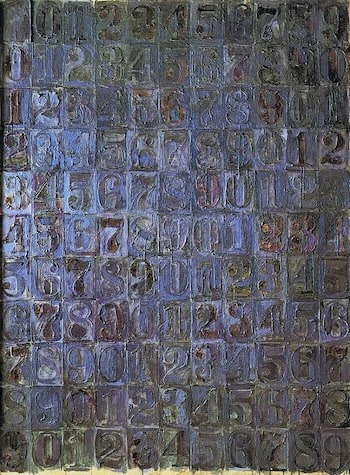Gray Numbers, 1958 by Jasper Johns

Perhaps Johns turned his attention to Cubism when in Three Flags (1958) he further questioned the idea of the picture plane. The object that he created superimposes
three painted images of the flag, with each successively smaller flag obliterating part of the one beneath. The object that results is an amalgam of painting and sculpture. He has painted flat
images (the flag), but the picture plane cannot be defined. Is it the largest canvas and do the others project; is it the smallest with the others receding? This concern with the plane recurs
throughout his career; in later works the clues are more subtle and the surface is not broken. Most recently he has used clues directly from the Cubist vocabulary; in Three Flags the idea
is still abstracted and formal, and may also be a comment on the integrity of the surface in the paintings of his peers such as Noland and Kelly. We could incidentally speculate on further
repetition: three is conventionally regarded as the first number in a mathematical series that progresses from three to infinity.
Johns soon turned to two similar subjects: Numbers and Alphabets; both have a coherent, abstract quality. They are part of the ordinary world, and generally (unless we are typographers) we ignore
their form. We also rarely question the significance of a single number or letter, that is, how it compares with, say, a box or even a flag. How do individual letters or numbers interact with
others to create language and meaning? With an apparent disregard for these questions, Johns arranged his subjects in simple rows that filled the entire canvas; the idea may have come from a
school book or an oculist's chart. The numbers themselves were frequently stenciled using ordinary packing-case stencils, which enabled him to repeat effortlessly the letter's form and to
concentrate on painting it (in encaustic). He did not make words or inscriptions; the letters are workmanlike and straightforward. Johns admitted to Leo Steinberg that he liked the stencil
letters best, and Steinberg, in disbelief, pressed him further:
Q: Do you use these letter types because you like them or because that's how the stencils come?
A: But that's what I like about them, that they come that way.
These paintings again gave Johns the chance to use a subject that is given, common or impersonal. The letters also become anonymous and "not looked at." This vocabulary is similar to that of the
Cubist still life created by Picasso, in which standard objects - bottles, guitars, violins, and sheet music - are the basic material for formal analysis.
Gray Numbers is a large canvas created by Johns in 1958. The numbers are painted all over within a consistent grid, except the upper left-hand rectangle is left blank. There are eleven
characters in each row. Each vertical left-hand row begins with a different number, while the right-hand edge has the same numbers, except for the top row.
